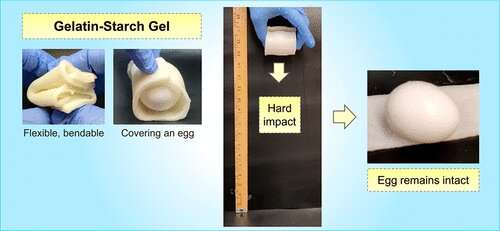New gel protects eggs—and maybe someday, heads—from damage

Humpty Dumpty, the famous egg of nursery rhyme fame, fell off a wall and couldn't be put back together again. But if he'd worn a protective jacket made of gelatin and cornstarch, he could have stayed intact. Researchers in ACS Applied Materials & Interfaces report that by adding starch to gelatin, they have created gels that protect fragile objects, such as eggs—and maybe someday, people's heads.
Even though bubble wrap and packing peanuts are meant to keep delicate items safe, sometimes they don't work well enough, and items can still break. Similarly, the padding in helmets helps protect people's heads from injury during violent contacts in hockey, skateboarding and horseback riding. But some athletes still develop brain injuries from being hit very hard or falling on a hard surface. Therefore, thin, flexible materials that do a better job absorbing and dissipating the force from impacts are needed.
Previously, researchers have developed elastomer foams for this purpose, but hydrogels—networks of polymer chains plumped up by water molecules—are another possibility. So, Srinivasa Raghavan, Sairam Ganesh and Nikhil Subraveti wanted to formulate hydrogels that could shield against strong impacts. They used eggs and blueberries as models for fragile objects and tested the hydrogels' abilities to keep them safe.
The researchers made hydrogel films with gelatin and added cornstarch granules. The result was a cloudy material that could reduce the force of an impact up to 15% compared to films made of pure gelatin. They determined that gels with 10% gelatin and 10–20% starch were ideal in terms of their flexibility and impact absorption.
Next up was a series of tests to see whether the gel could keep eggs and blueberries safe. Eggs wrapped in the gelatin-starch gel stayed intact when they were dropped onto a table, whereas pure gelatin-wrapped eggs broke. And blueberries sandwiched like ravioli between two layers of the gelatin-starch gel stayed intact when 1.7-ounce weights were dropped on them. The protective nature of starch-containing hydrogels, as well as their inexpensive and biodegradable ingredients, means that these materials could be useful for sports equipment, defense materials and packaging for fragile consumer goods, the researchers say.
More information: Sairam Ganesh et al, How a Gel Can Protect an Egg: A Flexible Hydrogel with Embedded Starch Particles Shields Fragile Objects Against Impact, ACS Applied Materials & Interfaces (2022). DOI: 10.1021/acsami.2c01261
Journal information: ACS Applied Materials and Interfaces
Provided by American Chemical Society





















